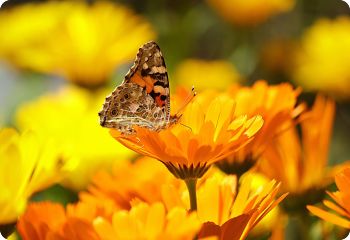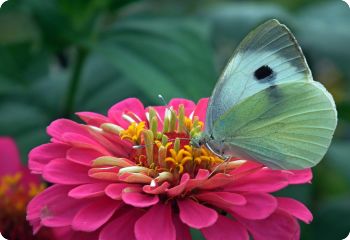Flowers for Butterflies
by Diane Linsley
What are the best flowers for butterflies?
Butterflies bring the garden to life with motion and beauty. Sadly, with the ongoing disappearance of wild land in our modern world, many butterflies are endangered and at risk of going extinct. The best way to protect them is to provide a safe habitat for them in your own organic garden.
How to Attract Butterflies
Adult butterflies are attracted to brightly colored flowers with shallow nectar tubes. They like to feed in the sun, so plant flowers in sunny spots. Morning to afternoon sun is best.
Butterflies lay their eggs on host plants that feed their larvae. Each butterfly species has its own food preferences. The more variety you have, the more butterflies you will attract.
Native Flowers for Butterflies
Are native flowers better for attracting butterflies than non-natives? You may notice that butterflies visit both types of flowers. So what's the big deal?
If you look at the list of butterfly host plants, you'll see that butterflies are picky about where they lay their eggs. Some butterfly larvae can only eat the leaves of a very small range of plants. For example, Monarch larvae can only feed on members of the milkweed family. Many of the host plants happen to be native wildflowers.
One reason why butterflies are endangered is because their host plants in the wild are disappearing. Host plants may not seem as glamorous as flowers, since watching adult butterflies is more entertaining than watching caterpillars. But we need to consider the needs of the butterfly in all its stages of life, including the "ugly duckling" stage.
Here's my list of the best flowers for butterflies and the host plants that support them through all the stages of life.
Annual Flowers for Butterflies
Ageratum - Fuzzy, purple-blue flowers for butterflies and beneficial insects.
Alyssum - Masses of tiny white, pink or purple flowers from summer to fall. Self-sowing annual. Easy to grow from seed.
Calendula - Cheerful yellow, orange or apricot flowers. Easy to grow from seed.
California Bluebells - Cobalt-blue flowers for butterflies. Native wildflower. Easy to grow from seed.
Coreopsis - Yellow, gold or mahogany-red flowers. Native wildflower.
Cosmos - Late summer flowers in a variety of colors, heights and styles.
German Chamomile - Small, daisy-like flowers from summer to fall. Attracts butterflies and beneficial insects. Easy to grow, self-sowing, annual herb.
Larkspur - Tall spikes of purple, blue, lavender, pink, rose and white flowers.
Lavatera trimestris - Large, cup-shaped pink or white flowers in midsummer.
Linaria maroccana - Tiny, snapdragon-like flowers in a wide range of colors.
Linum grandiflorum - Annual wildflower with scarlet-red, salmon or white flowers. Easy to grow. Self sows on bare soil.
Marigold - Showy flowers for butterflies. Blooms in shades of yellow, gold, orange and red. Easy to grow from seed.
Monarda citriodora - Native wildflower for butterflies and hummingbirds.
Phlox drummondii - Red, pink or white flowers. Native wildflower. Easy to grow from seed.
Salvia farinacea - Deep blue flowers for butterflies. Native wildflower.
Tithonia 'Torch' - Orange-red flowers for butterflies and hummingbirds.
Zinnia - Colorful annual flowers that attract butterflies and hummingbirds.
Perennial Flowers for Butterflies
Agastache foeniculum - Lavender-blue flowers for butterflies. Native perennial. Blooms the first year from seed.
Allium - Round balls of purple flowers for butterflies in early summer.
Alyssum saxatile - Masses of yellow flowers for butterflies in late spring. Easy to grow from seed.
Aster - Spring or fall-blooming perennials with flowers in various colors.
Centranthus ruber - Masses of reddish-pink or white flowers in late spring. First-year flowering perennial for butterflies and hummingbirds.
Delphinium - Stunning blue, purple, pink or white flowers on tall stems. Great for butterflies and hummingbirds.
Dianthus barbatus - Sweet William. Pink, white or crimson flowers for butterflies in early summer.
Gaura lindheimeri - Native perennial. Pink-tinged, white flowers on tall stems.
Hesperis matronalis - Light violet or white flowers for butterflies and hummingbirds. Easy to grow from seed.
Iberis gibraltarica - Low-growing, evergreen perennial with pale lavender-pink flowers for butterflies in late spring. Makes a good groundcover.
Lavandula angustifolia - Highly fragrant flowers for butterflies in midsummer.
Linum narbonense 'Heavenly Blue' (Flax) - For butterflies and native bees.
Lunaria annua - Shade-tolerant biennial with purple flowers in late spring, followed by showy seed pods.
Lychnis - Heirloom perennials with scarlet-red, purplish-pink or white flowers for butterflies and hummingbirds. Blooms for a long time in summer.
Malva sylvestris 'Zebrina' - Pale pink flowers with purple stripes. First-year flowering perennial for butterflies and hummingbirds. Self sows.
Ratibida columnifera - Red or yellow flowers for butterflies. Native wildflower.
Salvia - Perennials with tubular flowers for butterflies and hummingbirds.
Saponaria ocymoides - Groundcover or rock garden perennial with bright pink flowers in May and June.
Scutellaria resinosa - Deep purple-blue flowers tipped with white. Native, drought-tolerant, rock garden perennial.
Shasta Daisy - Single or double, pure white flowers with yellow centers. Attracts butterflies from June to August.
Butterfly Host Plants
Asclepias tuberosa - (Butterfly Weed) - Native perennial. Host plant for Queen, Gray Hairstreak, and Monarch butterfly larvae, which can only eat members of the milkweed family. One of the best flowers for butterflies and hummingbirds.
Bronze Fennel - Host plant for Black Swallowtail butterflies. The yellow umbel flowers attract many butterflies and beneficial insects.
Centaurea cyanus (Cornflower) - Host plant for Painted Lady butterflies. The flowers attract butterflies and beneficial insects. Easy to grow from seed.
Dalea purpurea - Native perennial. Host plant for Marine Blue, Reakirt's Blue, and Southern Dogface butterflies.
Dill - Host plant for Black Swallowtail butterfly larvae. The umbel flowers attract other butterflies and beneficial insects.
Echinacea purpurea - Native perennial. Host plant for Silvery Checkerspot butterfly larvae. The flowers attract butterflies and beneficial insects.
Gaillardia - Native perennial. Host plant for Bordered Patch butterfly larvae. Scarlet-red and yellow flowers that attract butterflies and beneficial insects.
Hollyhock - Tall biennial with large flowers. Host plant for Painted Lady and Tropical Checkered-Skipper butterflies.
Liatris spicata - Native perennial. Host plant for Painted Lady and Silvery Checkerspot butterflies. Tall spikes of purple flowers for attracting butterflies and hummingbirds.
Lupinus perennis - Host plant for Eastern Tailed-Blue, Frosted Elfin, and the endangered Blue Karner butterflies.
Morning Glory - Host plant for Mexican Fritillary butterflies.
Myosotis sylvatica - Host plant for American Lady butterflies.
Parsley - Host plant for Black Swallowtail butterfly larvae. The umbel flowers attract butterflies and beneficial insects.
Rudbeckia - Native wildflower. Host plant for Painted Lady and Silvery Checkerspot butterfly larvae. The flowers attract beneficial insects.
Ruta graveolens - Host plant for Black Swallowtail, Broad-banded Swallowtail, Giant Swallowtail, and King Swallowtail butterflies.
Snapdragon - Host plant for the Common Buckeye butterfly. The flowers attract bumblebees.
Sunflower - Host plant for Painted Lady, Bordered Patch, Gorgone Checkerspot and Silvery Checkerspot butterflies. The large, pollen-laden flowers attract many butterflies and beneficial insects.
Sweet Pea - Host plant for Eastern Tailed-Blue butterflies.
Verbena bonariensis - Host plant for Common Buckeye butterflies. One of the best flowers for butterflies and hummingbirds.
Viola tricolor - Host plant for Variegated Fritillary, Great Spangled Fritillary, and Gray Hairstreak butterflies. The small flowers provide food for butterflies and beneficial insects in the cool weather of early spring and fall when there are few other flowers in bloom.
Related Articles
Flowers for Hummingbirds - The best flowers for attracting hummingbirds.
Flowers for Beneficial Insects - Support your local ladybugs and lacewings.
Self-Sowing Annuals - Flowers that reseed and come back every year.
Recommended Books
Attracting Native Pollinators by The Xerces Society
Gardening for Butterflies: How You Can Attract and Protect Beautiful, Beneficial Insects by The Xerces Society
Seeds

